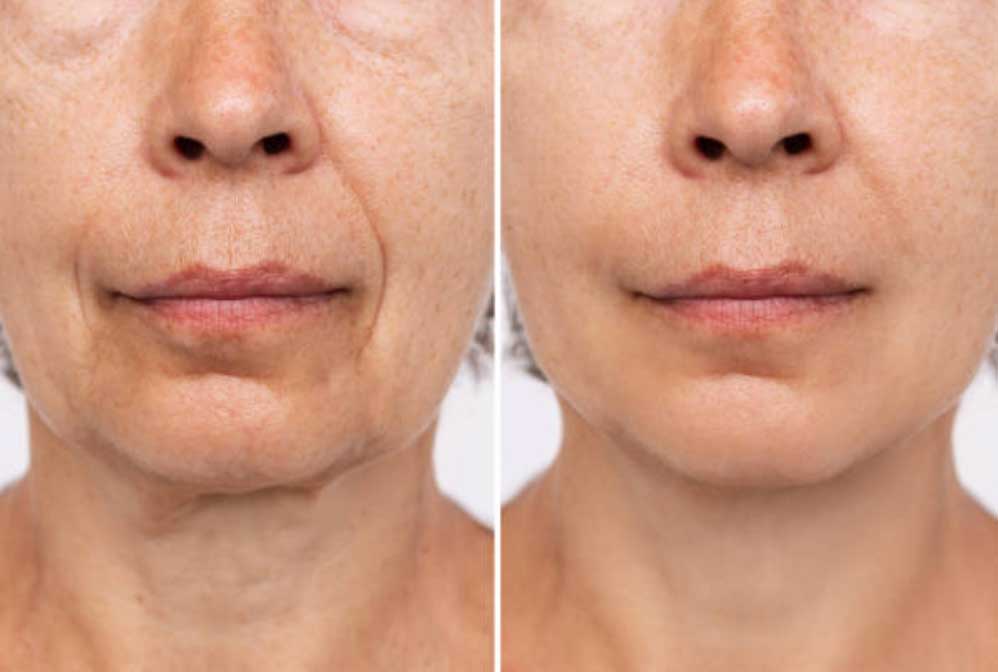What’s The Difference between a Full Facelift and a Mini Facelift?
When it comes to combating the visible signs of ageing, you might have come across a plethora of options, including facelift procedures. These are surgical interventions designed to rejuvenate your facial aesthetics by addressing anatomical changes that happen within the soft tissues and skeletal structure of the face (things that can never be addressed by injectables). You’ve probably heard of the terms ‘full facelift’ vs ‘mini facelift’, but do you know the differences between these two procedures? In this blog, Consultant Plastic Surgeon Anthony MacQuillan aims to discuss the differences between the two, helping you make an informed decision about which procedure might be right for you.
The world of facelift procedures can seem overwhelming at first. However, understanding the basics can help you navigate through the options with more confidence. Facelifts are not a one-size-fits-all solution. They are tailored to address specific areas of concern and can be customised to suit an individual’s unique needs and expectations.
A facelift procedure, in essence, is a surgical procedure that lifts sagging facial tissues to restore a more naturally youthful facial appearance and additionally adds volume to the face (in the majority of cases). It is often said to “turn back the clock,” helping a patient look as young as they feel (it is important to remember that it won’t stop the clock from ticking!).

What Is a Full Facelift?
The term ‘full facelift’ refers to a comprehensive surgical procedure that addresses the visible signs of ageing across the face and can be combined with a neck lift to maximise rejuvenating impact. A full face and neck lift aims to correct sagging over the lateral portion of the cheeks, reduce the deep creases of the nasolabial folds and marionette lines (you can never take these away totally – even young children have nasolabial folds), improve muscle tone over the front of the neck (caused by laxity in the platysma muscle), improve the shape of the jaw line reducing the appearance of the jowls, and correct a double chin. It is considered the gold standard in facial rejuvenation and can significantly enhance your facial contours and skin tone.
During a full facelift procedure, incisions are usually made beneath the sideburn, extending down around the ear and ending at the lower scalp. Anthony then repositions the deep tissue layer known as the SMAS (this stand for Superficial Musculo Aponeurotic System), pulls the skin back, and removes the excess. The result is a smoother, firmer, and more youthful-looking face.
A full facelift is a more extensive procedure and is typically recommended for individuals experiencing advanced signs of ageing. It offers more dramatic and long-lasting results. However, it also comes with a longer recovery period and a higher cost.
What Is a Mini Facelift?
On the other hand, a mini facelift is a less invasive surgery that focuses on improving the shape of the jawline. It targets sagging skin and loss of tone along the lower border of the mandible (jaw), and can soften the nasolabial folds and marionette lines. The idea candidate for a miniface lift has a thinner face and a loss of jaw definition predominantly caused by skin laxity rather than additional volume (for some people the jowls is the result of additional soft issue volume).
The procedure itself uses stitches placed within the SMAS to concertina it together (like ruching fabric). Scar tissue then forms between the folds holding it in place in the long term after the stitches have dissolved. There are many types of mini facelift (called many different things by surgeons who perform them – one stich lifts, S-lifts, R-lifts, VR-lifts or MACS lifts) however they all rely on the concertina or bunching effect rather than on undermining the SMAS and lifting it into a new position.
Because the anatomy is not repositioned in the same way as in a more extensive technique (such as deep plane facelift) the extent of effect is more limited and it is unrealistic to expect much long term effect on the shape of the neck or to anticipate as significant a change in mid face, nasolabial folds and marionette lines.
In a mini facelift procedure, Anthony makes smaller incisions, usually along the hairline and behind the ear. The skin and underlying tissues are lifted, and excess skin is removed. The incisions are then closed with sutures.
Because a mini facelift is less extensive than a full facelift, it generally has a shorter recovery period and is less expensive. However, the results may not be as dramatic or long-lasting as those from a full facelift.

Key Differences between Full Facelift and Mini Facelift
While both full facelift and mini facelift procedures aim to rejuvenate the face and combat signs of ageing, there are key differences between the two. These differences lie in the extent of the procedure, the areas of the face targeted, the length of the recovery period, and the cost.
A full facelift is a more comprehensive procedure that addresses all areas of the face below the lower eyelids and the neck. It is a more invasive technique that produces its effect through repositioning of underlying the SMAS tissue, removal of excess skin, tightening of the platysma (by pulling it backwards) and elevating the facial fat pads (to reposition facial volume) through traction on the SMAS. This results in more dramatic transformations and longer-lasting results. But the recovery period is longer, and the cost is higher.
In contrast, a mini facelift is a less invasive procedure that focuses on the lower third of the face. It generally involves a shorter incision (the part behind the ear is shortened) and less extensive surgery – the area of skin that is undermined is less, there is no surgery performed below the level of the SMAS and there is minimal intrusion into the neck. The results are more subtle and may not last as long as those from a full facelift. The recovery period is shorter, and the cost is lower.
Full Facelift Vs Mini Facelift – How Is the Surgery Performed?
Both full and mini facelift procedures can are performed under anaesthesia. However, the exact procedures vary, reflecting the different goals and extent of each surgery.
In a full facelift, Anthony makes incisions that start below the sideburn, extending down around the ear, continuing upwards in the sulcus behind the ear and then crossing into the scalp. The skin is then separated from the underlying SMAS tissue which is then incised and pocket created beneath it allowing it to be advanced upwards and backwards (repositioning the skin and the subcutaneous fat pads). The platysma muscle is then tightened by moving it backwards (posteriorly), and excess skin is then removed.
A mini facelift, on the other hand, involves a shorter incision behind the ear that does not usually cross into the hair line (because less skin is recruited from the neck). The skin is lifted, and the SMAS tightened with sutures and any excess skin is removed, before the incisions are closed with sutures.
Expected Results: Full Facelift vs Mini Facelift
The expected results from a full facelift and a mini facelift are different, reflecting the different goals and extent of each procedure.
A full facelift can produce dramatic transformations. It can significantly improve a sagging jawline, deep creases around the nasolabial folds and marionette line, jowls, and a double chin. The results are long-lasting, usually providing 7 to 10 years worth of wear.
In contrast, a mini facelift produces more subtle results. It can improve sagging skin and loss of tone in the lower third of the face. The results are less dramatic and may not last as long as those from a full facelift, typically around 3 to 5 years.
Recovery Time: Full Facelift vs Mini Facelift
The recovery time for a full facelift is longer than that for a mini facelift. After a full facelift, patients may need to take two to three weeks off from work or their regular activities. They may experience swelling, bruising, and discomfort, which can be managed with medication. Return to all normal activities is usually about 4 weeks however swelling will go up and down in the areas that have been operated on for up to a year following surgery.
Conversely, the recovery time for a mini facelift is generally shorter. Patients may be able to return to their normal activities within 2 to 3 weeks. They may experience less swelling, bruising, and discomfort than after a full facelift and it is unusual for swelling to persist for more than 3 months (reflecting the less invasive nature of the procedure).
Cost Comparison: Full Facelift vs Mini Facelift
The cost of a full facelift is higher than that of a mini facelift. This reflects the more extensive nature of the surgery, the longer operating time, and the longer recovery period. However, since a full facelift offers more dramatic and long-lasting results, many people feel that the higher cost is worth it.
On the other hand, a mini facelift is less expensive (due to the shorter operating time). However, since the results may not be as dramatic or long-lasting, some people may feel that they need to have the procedure repeated after a few years.
Choosing the Right Procedure for You: Full Facelift vs Mini Facelift
The choice between a full facelift and a mini facelift depends on your individual needs, goals, and circumstances. If you are experiencing advanced signs of ageing across your entire face and neck and are seeking a dramatic transformation, a full face and neck lift may be the right choice for you.
If you are primarily concerned with ageing in the lower third of your face (essentially loss of jaw line definition), and you prefer a less invasive procedure with a shorter recovery period, a mini facelift may be a better fit.
As with any cosmetic surgical procedure it is crucial to consult with a consultant plastic surgeon who is on the GMC specialist register, such as Anthony, to discuss your options and determine the best procedure for you.

FAQs about Facelift and Mini Facelift Surgery
What is the recovery time for a mini facelift?
- The recovery period for a mini facelift is generally shorter compared to a full facelift. Most patients can resume their normal activities within 2 to 3 weeks post-surgery. However, it’s important to note that recovery can vary based on individual factors such as age, health, and the body’s natural healing process. During this time, patients may experience some swelling and bruising, which subsides within a few weeks.
Who is the best candidate for a mini facelift?
- Ideal candidates for a mini facelift are usually individuals in their 40s to 50s who exhibit mild to moderate signs of ageing. This includes sagging skin, wrinkles, and a desire for facial rejuvenation without the need for a more invasive procedure. Candidates should be in good overall health, non-smokers (as smoking impedes the healing process and is likely to result in skin necrosis). They should also have realistic expectations about the outcomes of the surgery.
Can a mini facelift be combined with other procedures?
- Yes, a mini facelift can often be combined with other cosmetic procedures to enhance the overall result. Common combinations include eyelid surgery (blepharoplasty) to address aging around the eyes and volume restoration with fat grafting. Combining procedures can address multiple concerns simultaneously, but it’s important to discuss the options and potential risks with Anthony.
Who is an ideal candidate for a full facelift?
- Ideal candidates for a full facelift are typically individuals in their 40s to 70s who have significant signs of ageing. These include deepening of the skin folds (nasolabial folds and marionette lines), sagging skin, jowls, and ageing changes evident in the neck. Candidates should be in good overall health, have realistic expectations about the results, and be prepared for a longer recovery time compared to less invasive procedures.
How long does a full facelift last?
- The results of a full facelift typically last approximately 10 years, although this varies depending on several factors. These include the individual’s skin quality, genetics, lifestyle choices (such as sun exposure and smoking), and overall ageing process. Maintaining a healthy lifestyle and skin care regimen can help prolong the results.
What is the recovery time for a full facelift?
- Recovery time for a full facelift varies among individuals, but most patients can return to their normal activities within 2 to 4 weeks (for exercise it is more like 4 weeks). It is important to note that full recovery, including the complete subsidence of swelling and the maturation of facial contours take a year. Patients are advised to follow post-operative care instructions closely to ensure a smooth recovery.
Are the results of a full facelift natural-looking?
- When performed by a skilled and experienced plastic surgeon, a full facelift yields natural-looking results. The goal is to rejuvenate the face in a way that looks refreshed and authentic, without over-tightening the skin or altering fundamental facial characteristics. A good facelift should enhance the patient’s features and not give them an entirely different appearance. Choosing the right plastic surgeon and having a thorough consultation about the desired outcomes are key steps in achieving natural-looking results.
Further Reading about Face Procedures with Anthony MacQuillan
- Read more about Facelift Surgery
- Read more about Ear Correction Surgery
- Read more about Eyelid Surgery
- Read more about Visible Effects of Ageing That Can Be Improved With a Facelift
- Read more about Top Tips to Sleep Better After Facelift Surgery
- Read more about What is a Mini Facelift
Medical References about Facelift and Mini Facelift Surgery
- Erase Ageing With a ‘Mid-Facelift’?
- How Face Lifts Affect Wrinkles and Lines
- Face-lift – Mayo Clinic
- Facelift, Mini Facelift, & Neck Lift – University of Utah Health



